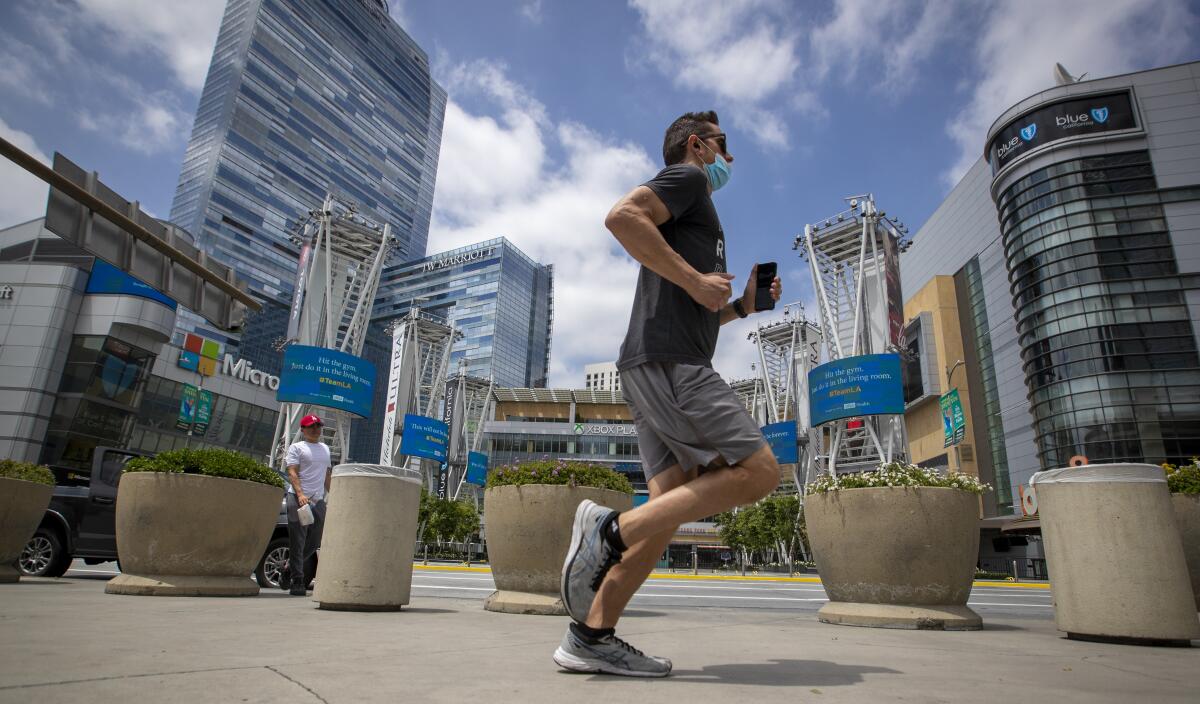Everything you need to know about California’s mandatory mask rules

- Share via
Mask wearing in many public places is now the law of the land in California, thanks to action by Gov. Gavin Newsom this week.
All Californians must wear face coverings in public or high-risk settings, including while shopping, taking public transit or seeking medical care to help curb the spread of the coronavirus.
Here is what we know.
Why now?
Newsom said he became concerned because many people were not wearing masks in public places. County rules varied, and some local officials refused to require face coverings.
“Simply put, we are seeing too many people with faces uncovered — putting at risk the real progress we have made in fighting the disease,” Newsom said in a statement. “California’s strategy to restart the economy and get people back to work will only be successful if people act safely and follow health recommendations. That means wearing a face covering, washing your hands and practicing physical distancing.”
Last week, the Orange County public health officer resigned after weeks of verbal attacks, including a death threat, over her mandatory mask rules. Her replacement rescinded the rules amid intense pressure from the Board of Supervisors, and now the county only “strongly recommends” wearing masks in public settings.
Newsom’s action means that there a uniform policy across the state.
How will it be enforced?
For the most part, authorities have said they plan to ask for voluntary compliance. At beaches, police and lifeguards have encouraged people to practice social distancing and wear masks but have generally not written citations.
Orange County Sheriff Don Barnes has indicated that it’s not law enforcement’s job to ensure compliance with the state’s mask order. Instead, “it is each person’s responsibility to wear a face covering, and follow other recommended safeguards, in order to stop the spread of COVID-19,” he said.
“I expect that Orange County residents will continue to use common sense approaches for the benefit of their own health, as well as the collective health of other county residents,” he said in a statement. “We must do what is necessary to stop the transmission of COVID-19, enabling us to further open remaining businesses, places of recreation, and the hospitality industry.”
Officials in Riverside County, which previously rescinded a face-covering requirement, urged residents to follow the state’s new rules.
“Social distancing, washing our hands and wearing facial coverings are all simple measures that we can all abide by to protect ourselves and our fellow neighbors,” Riverside County Board of Supervisors Chairman V. Manuel Perez said in a statement. “I am happy that our governor has made this decision.”
Why has this been so controversial?
Some people simply don’t believe the government should force them to wear masks.
Mask use is far from uncommon, but the anti-mask political movement is undeniable.
In addition to the drama last week in Orange County, other counties have buckled to public pressure. Fresno County had a face mask rule for less than a day before it was pulled back. Riverside and San Bernardino counties revoked their orders after blowback. In Stockton, Mayor Michael Tubbs proposed face covering rules but failed to get any support from the City Council.
Many of California’s other most populous counties, including Los Angeles, San Diego, Santa Clara, Alameda, Sacramento, Contra Costa, San Francisco and San Mateo, require mask wearing in public.
Why is mask wearing so important?
Many health officials say that face coverings are an integral tool in the fight against COVID-19 because they can block transmission of the respiratory droplets released by infected people, even those who are asymptomatic, when breathing or talking.
Research published by the journal Disaster Medicine and Public Health Preparedness in 2013 found that homemade cloth masks “significantly” reduced the amount of potentially infectious droplets expelled by the wearer.
“It’s the only way we get back to work — it’s to mask,” said Dr. Kirsten Bibbins-Domingo, chair of UC San Francisco’s Department of Epidemiology and Biostatistics. “All of the data tells us ... it’s pretty clear that masking is the element that changes the trajectories of the COVID pandemic.”
There’s increasing evidence that face coverings are essential to allowing a broader reopening. Places that have kept coronavirus transmission under control, such as Hong Kong and Taiwan, have virtually universal wearing of masks in public.
A recent study out of Germany found that masks reduced the daily growth rate of reported infections by around 40%. Another study published in the Proceedings of the National Academy of Sciences concluded that “wearing of face masks in public corresponds to the most effective means to prevent interhuman transmission.”
In one Missouri salon, two hairstylists became sick but no customers were infected, and scientists believe it was because they were wearing face masks. And many countries where masking is socially routine, including Japan, have not seen an out-of-control national epidemic.
California Public Health Officer Dr. Sonia Angell said wearing face coverings is an effective way to decrease the spread of the coronavirus.
“As Californians venture into our communities more, wearing face coverings is another important way we can help protect one another,” she said.
Dr. Shruti Gohil, associate medical director of epidemiology and infection prevention at UC Irvine, said face coverings, in addition to frequent hand washing, are helpful in reducing the spread of infection as communities reopen and physical distancing becomes less possible.
“In my opinion, if we want to reengage we have to put all of our energy into figuring out how to shave off every piece of risk that we can, reasonably, without crippling our society,” she said. “I do think it’s hard for the public to digest what the right steps are, and I think in a time of pandemic it is nice to have authorities steer the ship as stably as possible. I do think that perhaps the governor’s move allows for that at some level.”
Dr. Peter N. Bretan, president of the California Medical Assn., said Newsom’s order was a reminder that the “COVID-19 crisis is not over.”
When must you wear a mask?
• Inside, or in line to enter, any indoor public space.
• Obtaining health-related services including, but not limited to, a hospital, pharmacy, medical clinic, laboratory, physician’s or dental office, veterinary clinic or blood bank.
• Waiting for or riding on public transportation or paratransit or while in a taxi, private car service, or ride-sharing vehicle.
• Engaged in work, whether at the workplace or performing work off site, when interacting in-person with any member of the public.
• Working in any space visited by members of the public, regardless of whether anyone from the public is present at the time.
• Working in any space where food is prepared or packaged for sale or distribution to others.
• Working in or walking through common areas, such as hallways, stairways, elevators and parking facilities.
• In any room or enclosed area where other people (except for members of the person’s own household or residence) are present when unable to physically distance.
• Driving or operating any public transportation or paratransit vehicle, taxi, or private car service or ride-hailing vehicle when passengers are present. When no passengers are present, face coverings are strongly recommended.
• Outdoors in public spaces when maintaining a physical distance of six feet from persons who are not members of the same household or residence is not feasible.
Who is exempt?
• Children 2 years old or younger, who should not wear a face covering because of the risk of suffocation.
• Persons with a medical condition, mental health condition or disability that prevents wearing a face covering. This includes persons with a medical condition for whom wearing a face covering could obstruct breathing or who are unconscious, incapacitated or otherwise unable to remove a face covering without assistance.
• Persons who are hearing impaired, or communicating with a person who is hearing impaired, where the ability to see the mouth is essential for communication.
• Persons for whom wearing a face covering would create a risk related to their work, as determined by local, state or federal regulators or workplace safety guidelines.
• Persons who are obtaining a service involving the nose or face for which temporary removal of the face covering is necessary to perform the service.
• Persons who are seated at a restaurant or other establishment that offers food or beverage service, while they are eating or drinking, provided that they are able to maintain a distance of at least six feet from persons who are not members of the same household or residence.
• Persons who are engaged in outdoor work or recreation such as swimming, walking, hiking, bicycling or running, when alone or with household members, and when they are able to maintain a distance of at least six feet from others.
• Persons who are incarcerated. Prisons and jails, as part of their mitigation plans, will have specific guidance on the wearing of face coverings or masks for both inmates and staff.
What are some mask basics?
The California Department of Public Health previously issued these guidelines for cloth masks:
- Face coverings can be made out of cloth, factory-made or hand-sewn, or improvised using bandannas, scarves, T-shirts, sweatshirts or towels.
- The material should cover both the nose and mouth.
- Ideally, face coverings should be washed after each use, or at least daily.
- Dirty masks should be placed in a dedicated laundry bag or bin and laundered with detergent and hot water and dried on a hot cycle.
- Be sure your mask is comfortable; you don’t want to have to keep adjusting the mask, because that means touching your face.
- Wash your hands, or use hand sanitizer, before and after touching your face or face coverings.
- If you must wear your cloth face covering again before washing it, wash your hands immediately after putting it back on and avoid touching your face.
- Discard cloth face coverings that no longer cover the nose and mouth, have stretched-out or damaged ties or straps, cannot stay on the face, or have holes or tears in the fabric.
More to Read
Sign up for Essential California
The most important California stories and recommendations in your inbox every morning.
You may occasionally receive promotional content from the Los Angeles Times.















